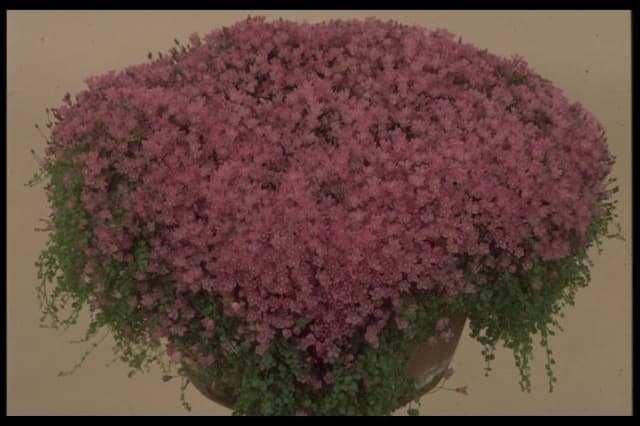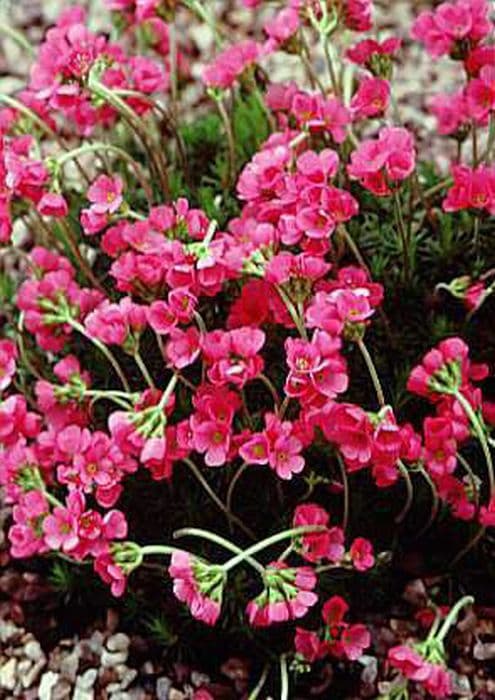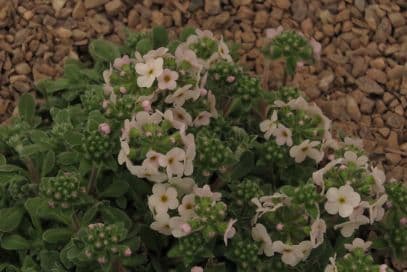Double Cream Primrose Primula Belarina Cream = 'Kerbelcrem' (PBR) (Belarina Series) (Pr/prim/d)
![primrose [Belarina Cream]](/_next/image?url=https%3A%2F%2Fplants-admin.emdemapps.com%2Fimages%2Fplants%2F%2Fimages%2F604b5a770b228.png&w=3840&q=75)
ABOUT
Primula Belarina Cream, part of the Belarina Series, is known for its lush, fully double flowers that exude a creamy hue, resembling the appearance of miniature roses. These blooms cluster together in rosettes atop a bed of deep green, crinkly foliage that forms a tidy, compact tuft. The dense cluster of petals in each blossom creates a textured, ruffled look that is both soft to the eye and touch. The delicate cream color of the flowers blends gracefully with the greenery, making this plant a subtle yet elegant choice for adding a touch of class to any garden display. The leaves themselves have a slightly textured surface, with scalloped edges that provide visual interest even when the plant is not in bloom. Overall, the Primula Belarina Cream is a charming and picturesque plant, adding a splash of gentle warm color and romantic appeal to any setting where it is planted.
About this plant
 Names
NamesFamily
Primulaceae
Synonyms
Cream Belarina Primrose, Double Primrose, Double Cream Primrose
Common names
Primula 'Kerbelcrem'
 Toxicity
ToxicityTo humans
The Primula, commonly known as the primrose, is typically not toxic to humans. However, some people may experience mild symptoms if they come in contact with the plant's sap or ingest its parts, due to skin sensitivities or allergic reactions. Such symptoms can include dermatitis or gastrointestinal discomfort if ingested, but these are not common.
To pets
The Primula, or primrose, is considered to be mildly toxic to pets, especially cats and dogs. If a pet ingests part of the plant, they may exhibit symptoms such as vomiting, diarrhea, or drooling. Some animals may also experience contact dermatitis from the plant's sap. It is advised to monitor the pet's condition and consult a veterinarian if symptoms worsen or persist.
 Characteristics
CharacteristicsLife cycle
Perennials
Foliage type
Evergreen
Color of leaves
Green
Flower color
Cream
Height
8 inches (20 cm)
Spread
8 inches (20 cm)
Plant type
Herb
Hardiness zones
4
Native area
Europe
Benefits
 General Benefits
General Benefits- Ornamental Appeal: The Primula Belarina Cream has double flowers with a rich creamy color, adding aesthetic appeal to gardens and landscapes.
- Compact Growth: Its compact size makes it suitable for small spaces, borders, and containers.
- Spring Bloomer: It flowers in early spring, providing early season color when many other plants are not yet in bloom.
- Long Flowering Period: The plant has a longer blooming period than many other primulas, offering a sustained display of flowers.
- Cold Tolerance: It is cold hardy and can survive frost, making it suitable for cooler climates and extending the gardening season.
- Low Maintenance: Requires minimal care once established, making it a good choice for gardeners of all skill levels.
- Attracts Pollinators: The flowers attract bees and butterflies, helping to support local ecosystems.
 Medical Properties
Medical PropertiesThis plant is not used for medical purposes.
 Air-purifying Qualities
Air-purifying QualitiesThis plant is not specifically known for air purifying qualities.
 Other Uses
Other Uses- The Belarina Cream primrose can be used in potpourri mixes, with its flowers contributing a delicate fragrance and appealing color.
- Pressed flower art incorporates the vibrant blooms of this plant to create unique and natural decorative pieces.
- Through plant dyeing techniques, the blossoms may be used to dye fabrics and fibers with soft yellow tones.
- Primula Belarina Cream can serve as an indicator plant in gardens, as its health often reflects the growing conditions and may signal the need for soil amendments or other care.
- In cake decoration, the edible flowers can adorn cakes and desserts for a touch of elegance and natural beauty.
- The flowers of this primrose are suitable for crafting homemade floral water or toners when steeped in distilled water.
- During springtime festivities or in weddings, the Belarina Cream primrose’s blossoms can be floated in water bowls for table centerpieces.
- They can be used in the study and education of botany and horticulture, providing live examples for pollination ecology and plant structure lessons.
- The plant can also play a role in sensory gardens, offering a soft texture and a pleasant fragrance for sensory stimulation.
- For hobbyist photographers, the photogenic Primula Belarina Cream flowers make for excellent subjects in macro or close-up photography.
Interesting Facts
 Feng Shui
Feng ShuiThe plant Primula is not used in Feng Shui practice.
 Zodiac Sign Compitability
Zodiac Sign CompitabilityThe plant Primula is not used in astrology practice.
 Plant Symbolism
Plant Symbolism- Hope: Primulas, also known as Primroses, often symbolize hope because they are one of the first flowers to bloom in the spring, signifying the end of winter and the arrival of new growth.
- Youth: The fresh and bright appearance of the Primrose is often associated with youthfulness and a playful spirit.
- Romance: With its delicate and cheerful blossoms, the Primrose can represent young love and affection.
- New Beginnings: The early blooming nature of the Primrose makes it a symbol for new beginnings and the start of a new cycle in life.
- Protection: In some folklore, Primroses are thought to protect against evil and to provide a haven for fairies, which could be a metaphorical way of expressing a protective charm.
 Water
WaterPrimulas, commonly known as English Primrose, prefer consistently moist soil, so it's important to water them whenever the top inch of soil feels dry to the touch. Typically, this will mean watering them once or twice a week, but the frequency may need to be increased during hot, dry spells. Use enough water to soak the root zone each time you water, which might equate to about a quarter of a gallon for a standard pot size. It's crucial not to overwater, as this can lead to root rot, particularly in poorly drained soils. During winter, when the plant is not actively growing, reduce watering frequency.
 Light
LightEnglish Primrose thrives in partial shade, so place them in a spot where they will be shielded from the intense afternoon sun, while still receiving some morning light or filtered sunlight throughout the day. They can tolerate some morning sun, but extended exposure to full sunlight may cause the leaves to scorch or the plant to bloom poorly.
 Temperature
TemperatureThe English Primrose prefers cool to moderate temperatures, thriving between 50°F to 75°F. They can tolerate temperatures down to about 20°F for short periods, but prolonged exposure to temperatures below this can be harmful. They are not well-suited to hot climates and can struggle when temperatures consistently exceed 80°F.
 Pruning
PruningPrune English Primrose to remove spent flowers and encourage a second bloom. Also, trim away any dead or yellowing leaves to maintain plant health and appearance. The best time to prune is after the main flowering period, typically after spring blooms fade. Pruning every few weeks during the flowering season helps promote continual blooms.
 Cleaning
CleaningAs needed
 Soil
SoilPrimroses, including the Primula Belarina Cream, thrive best in moist, well-draining soil rich in organic matter with a slightly acidic to neutral pH range of 6.0 to 7.0. A good soil mix for primroses can be made from one part garden soil, one part peat or coco coir, and one part perlite or sand to improve drainage.
 Repotting
RepottingPrimula Belarina Cream should be repotted annually in the late winter or early spring before they begin their growth cycle. Choose a container just one size larger than the current one to prevent overwatering issues.
 Humidity & Misting
Humidity & MistingPrimula Belarina Cream prefers high humidity levels, ideally between 50% and 70%. To maintain the right humidity, you can place the plant on a tray filled with water and pebbles, ensuring the pot is not sitting in the water directly.
 Suitable locations
Suitable locationsIndoor
Place in bright, indirect light; keep soil moist.
Outdoor
Part shade, moist soil, protect from midday sun.
Hardiness zone
4-8 USDA
 Life cycle
Life cycleThe life of Double Primrose, as Primula Belarina Cream is commonly known, begins with seed germination, which requires a period of cold stratification to mimic winter conditions and break dormancy. Upon sprouting, the plant enters the vegetative stage where it develops a rosette of leaves at the soil level. As it matures, it progresses to the flowering stage, typically in early spring, showcasing its double, creamy yellow flowers that attract pollinators. After pollination, seeds are produced and once mature, are dispersed to continue the cycle. Towards late spring or early summer, the plant may enter a period of dormancy, particularly in hotter climates, to conserve energy. As temperatures cool in fall, the plant may experience a second vegetative growth spurt before frost signals the approach of another dormancy period or the end of its annual life cycle, although many Primula species are perennial and will re-emerge the following spring.
 Propogation
PropogationPropogation time
Spring
The Primula Belarina Cream, commonly known as the Belarina Cream Primrose, is typically propagated by division as it is the most popular method for this ornamental plant. This technique involves carefully separating the plant's root ball into smaller sections, each with its own set of leaves and roots. Division is ideally performed in late summer or early fall after the blooming period is over, giving the new plants time to establish themselves before the onset of winter. With a sharp knife or spade, you go about dividing the clumps, making sure to minimize damage to the roots. Once divided, the new sections can be replanted into well-draining soil, ensuring they are well-watered until they are established.









